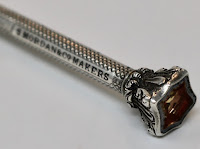"The hand is the tool of tools" - so said Aristotle, a little over 2300 years ago.
Over time, our tool of tools gradually came to represent many different aspects of the human condition, and by the Victorian era there were disembodied hands popping up just about everywhere, as they came to symbolize anything and everything deemed positive at the time - strength, fidelity, loyalty, romance...
This peculiar attachment to the unattached human hand resulted in a wide variety of household items being fashioned in ways that incorporated a hand, often female in appearance, and almost always the right. This included household items such as vases & dishes, and personal items such as jewellery & walking canes...
This peculiar attachment to the unattached human hand resulted in a wide variety of household items being fashioned in ways that incorporated a hand, often female in appearance, and almost always the right. This included household items such as vases & dishes, and personal items such as jewellery & walking canes...
... and of course ... pencils...
These three little pencils all date to the latter half of the 19th century. They are fairly tiny - the two gold ones are only 3.5" (9 cm) when fully extended.
The silver one is even smaller, at just 2.75" (7 cm) fully extended.
Given the size of these pencils and the attached ring on a couple of them, they were likely attached to ladies' chatelaines, or perhaps a small neck chain.
So why is the right hand the predominant one portrayed in the design of all of these items and pencils? The symbolism of the right hand has a long history of positive messaging, with various religions and cultures showing a clear bias towards the right. In Christianity for example, it is a place of honour - "the right hand of God". Many cultures imposed "rules" that governed which hand was used for which bodily function, with the right hand generally being the favoured one (e.g. for eating, greeting, etc.), and the left hand ... well, let's just not go there. Basically, since the beginning of time the left hand drew the short straw, and those born left hand dominant were often forced to "convert" and learn to use their right, often causing more harm than good - Left Hand Bias
For the most part we've gotten over the left vs. right debate (at least in terms of our appendages), and as unique as our hands may be in the animal kingdom, the disembodied hand has become far less of a "thing" since the mid-20th century... at least until this came along... "Thing T. Thing"
Sources :
- Wikipedia
- YouTube
- Images of vase, brooch, and cane downloaded from internet






















